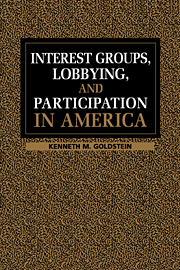Book contents
- Frontmatter
- Contents
- List of Figures and Tables
- Acknowledgments
- 1 Introduction
- 2 Patterns and Puzzles in Participation and Lobbying
- 3 The Political Logic of Political Decisions
- 4 Explaining Lobbying Decisions
- 5 Lobbying Decisions and the Health Care Reform Battle
- 6 Patterns of Recruitment and Participation in the Mass Public
- 7 Conclusion
- Appendix A Sources and Coding for Survey Data
- Appendix B Interest Group Sampling Frame
- Appendix C Chronology of Health Care Reform Legislation
- Bibliography
- Index
3 - The Political Logic of Political Decisions
Published online by Cambridge University Press: 23 September 2009
- Frontmatter
- Contents
- List of Figures and Tables
- Acknowledgments
- 1 Introduction
- 2 Patterns and Puzzles in Participation and Lobbying
- 3 The Political Logic of Political Decisions
- 4 Explaining Lobbying Decisions
- 5 Lobbying Decisions and the Health Care Reform Battle
- 6 Patterns of Recruitment and Participation in the Mass Public
- 7 Conclusion
- Appendix A Sources and Coding for Survey Data
- Appendix B Interest Group Sampling Frame
- Appendix C Chronology of Health Care Reform Legislation
- Bibliography
- Index
Summary
All animals are equal, but some animals are more
equal than others.
George Orwell, Animal FarmRemember, there are only three people in Congress
who really care what your employees think: their
two senators and their representative.
Mobilization manual from the chemical industryMost scholarly accounts of interest groups and lobbying have focused on how organizational factors and resources influence lobbying decisions and choices of tactics. I start from the premise that political factors also have a crucial influence. I assume that the architecture of the American political system also governs interest group actions. Therefore, to dissect the specific strategies and tactics lobbyists adopt in dealing with Congress, we must first identify what factors actually influence congressional elections and congressional decisions.
In the first part of this chapter, I take advantage of what scholars have learned about elections and legislative decision making to understand how and why grass roots strategies are used in lobbying campaigns. I argue that grass roots lobbying is an effective tool for interest groups to provide – in the way most likely to bias the process in their favor – the information required by voters when they decide for whom to cast a ballot and for legislators when they decide how to proceed on a particular piece of legislation.
- Type
- Chapter
- Information
- Interest Groups, Lobbying, and Participation in America , pp. 30 - 52Publisher: Cambridge University PressPrint publication year: 1999



